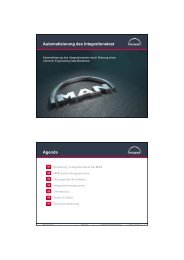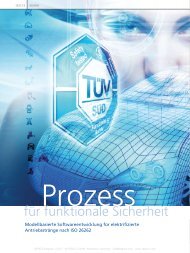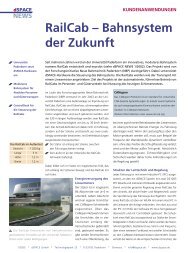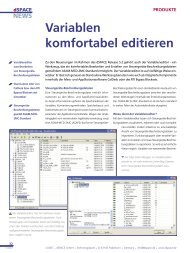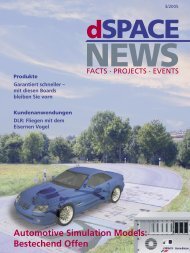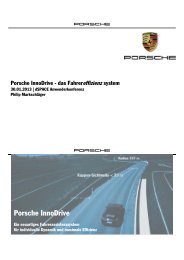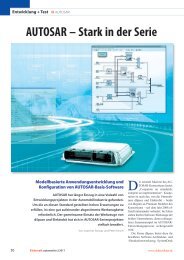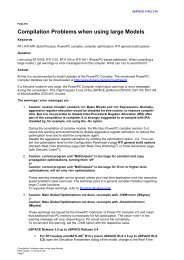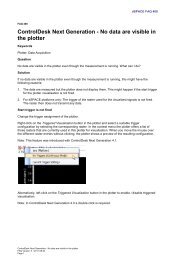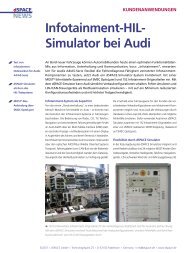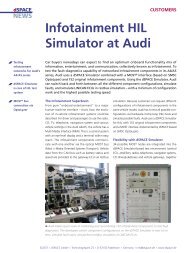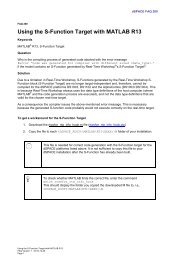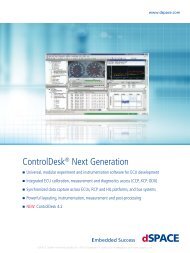magazinE - dSPACE
magazinE - dSPACE
magazinE - dSPACE
Create successful ePaper yourself
Turn your PDF publications into a flip-book with our unique Google optimized e-Paper software.
pAGe 44 CAN BUS<br />
Fig. 1: Selecting model signals for transmission<br />
via the RTI CAN MultiMessage Blockset.<br />
testing and automating the HIL<br />
simulator’s CAN communication.<br />
CAN monitoring in ControlDesk and<br />
CAN support for realtime testing<br />
are also prepared within the<br />
blockset.<br />
Can navigator is the<br />
Control Center<br />
In ControlDesk, the CAN Navigator’s<br />
tree is the central access point for<br />
handling CAN. The process of<br />
generating code for the realtime<br />
model supplies all the data needed<br />
for producing the tree: the user just<br />
has to insert a reference to the<br />
application in ControlDesk and the<br />
tree fills automatically (fig. 2). The<br />
tree then displays a consistent<br />
configuration of the CAN communication<br />
as defined in the model and<br />
configured with the RTI CAN<br />
MultiMessage Blockset.<br />
The tree visualizes all the CAN controllers<br />
contained in the model with<br />
their assigned DBC files, and the<br />
CAN messages with their signals.<br />
During run time, it can be used to<br />
switch between variants of the CAN<br />
controller’s DBC configuration. In<br />
addition to generating these layouts<br />
from the CAN MultiMessage<br />
Blockset in advance with Python, as<br />
was previously the case, users can<br />
now generate the layouts from the<br />
tree whenever they are needed –<br />
no Simulink installation is necessary<br />
Fig. 2: The CAN Navigator is the central<br />
access point to handle CAN in ControlDesk.<br />
(fig. 3). The layouts directly mirror<br />
the send and receive configurations<br />
of the messages and signals in the<br />
realtime model. Typical examples of<br />
such generated layout elements are<br />
input fields for setting the cycle<br />
and time buttons for transmitting<br />
messages sporadically.<br />
analyzing Communication<br />
Global layouts can be generated to<br />
handle the transmission control of<br />
multiple messages simultaneously. In<br />
the CAN Navigator, it is also possible<br />
to create layouts for the online configuration<br />
of CAN gateways – this is<br />
not possible in the blockset. There<br />
is a CAN monitoring window with<br />
various views (fig. 4, fig. 5) and sort<br />
options for comprehensive analysis<br />
of communication behavior.<br />
Monitoring can either be based on<br />
raw data or be performed symbolically<br />
with the current DBC reference.<br />
The messages selected for monitoring<br />
can be restricted via freely<br />
definable and savable filter rules, but<br />
it is also possible to visualize the<br />
entire CAN traffic. Pass and stop<br />
filters can be applied selectively to<br />
IDs, ID ranges and ECUs and can<br />
also be combined. The messages<br />
visualized in the CAN monitoring<br />
window can also be saved to a file<br />
(*.csv or *.asc). This file can be used<br />
as the starting point for preciselytimed<br />
CAN replays of the CAN<br />
Fig. 3: Tx layouts can be generated directly<br />
from the CAN Navigator.<br />
communication. For example, communication<br />
data recorded during<br />
real test drives can easily be reproduced<br />
in a restbus simulation on the<br />
HIL simulator as often as required.<br />
Testing under<br />
Real-Time Conditions<br />
For more complex test scenarios,<br />
there is RealTime Testing (RTT) for<br />
the Pythonbased development of<br />
realtime test scenarios. In this, the<br />
tests run timesynchronously to<br />
the realtime model, and read and<br />
write access can be performed to all<br />
model variables in each simulation<br />
clock cycle.<br />
If the realtime tests have to access<br />
the CAN bus, they are developed<br />
via a special library (canmmlib) for<br />
reading and writing rawdatabased<br />
messages. The necessary messages<br />
are added to the model by means of<br />
the RTI CAN MultiMessage Blockset<br />
and are then available in transparent<br />
form for realtime tests or for<br />
CAN replays of the CAN Navigator.<br />
The advantage is that changes to<br />
the CAN database or the model<br />
structure do not affect the executability<br />
of the realtime tests.<br />
An example test scenario is the<br />
monitoring of one of the HIL simulator’s<br />
analog input signals. When a<br />
defined trigger threshold (for<br />
example, 14.7 V) is exceeded, a



